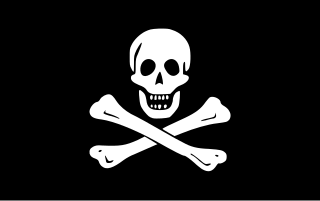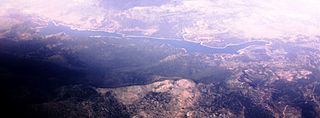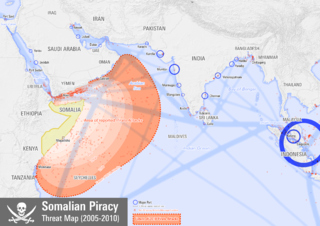
Piracy is an act of robbery or criminal violence by ship or boat-borne attackers upon another ship or a coastal area, typically with the goal of stealing cargo and other valuable goods. Those who conduct acts of piracy are called pirates, and vessels used for piracy are called pirate ships. The earliest documented instances of piracy were in the 14th century BC, when the Sea Peoples, a group of ocean raiders, attacked the ships of the Aegean and Mediterranean civilisations. Narrow channels which funnel shipping into predictable routes have long created opportunities for piracy, as well as for privateering and commerce raiding.

RFA Fort Victoria is a Fort-class combined fleet stores ship and tanker of the Royal Fleet Auxiliary of the United Kingdom tasked with providing ammunition, fuel, food and other supplies to Royal Navy vessels around the world. She is now the only member of her class.

USS Nicholas (FFG-47), an Oliver Hazard Perry-class frigate, was the third ship of the United States Navy to be named for Major Samuel Nicholas, the first commanding officer of the United States Marines. A third-generation guided missile frigate of the Oliver Hazard Perry class, she was laid down as Bath Iron Works hull number 388 on 27 September 1982 and launched 23 April 1983. Sponsor at her commissioning there on 10 March 1984 was the same Mrs. Edward B. Tryon who sponsored DD 449 in 1942.

The Frogman Corps is the maritime special operations force of the Danish Armed Forces part of Special Operations Command. On 1 July 2015, the Frogman Corps transferred from the Royal Danish Navy to the newly established Special Operations Command.
Operation Maslenica was a Croatian Army offensive launched in January 1993 to retake territory in northern Dalmatia and Lika from Krajina Serb forces, with the stated military objective of pushing the Serbs back from approaches to Zadar, Maslenica and Karlobag, allowing a secure land route between Dalmatia and northern Croatia to be opened. While an undoubted net Croatian tactical success, the operation was only a moderate strategic success, and was condemned by the UN Security Council.

Combined Task Force 150 (CTF-150) is a multinational coalition naval task force working under the 34-nation coalition of Combined Maritime Forces and is based in Bahrain established to monitor, board, inspect, and stop suspect shipping to pursue the "War on Terror" and in the Horn of Africa region (HOA) includes operations in the North Arabia Sea to support operations in the Indian Ocean. These activities are referred to as Maritime Security Operations (MSO).

Piracy in the Gulf of Guinea affects a number of countries in West Africa as well as the wider international community. By 2011, it had become an issue of global concern. Pirates in the Gulf of Guinea are often part of heavily armed criminal enterprises, who employ violent methods to steal oil cargo. In 2012, the International Maritime Bureau (IMB), Oceans Beyond Piracy and the Maritime Piracy Humanitarian Response Program reported that the number of vessels attacks by West African pirates had reached a world high, with 966 seafarers attacked during the year. According to the Control Risks Group, pirate attacks in the Gulf of Guinea had by mid-November 2013 maintained a steady level of around 100 attempted hijackings in the year, a close second behind the Strait of Malacca in Southeast Asia.
Piracy off the coast of Somalia occurs in the Gulf of Aden, Guardafui Channel, and Somali Sea, in Somali territorial waters and other surrounding places and has a long troubled history with different perspectives from different communities. It was initially a threat to international fishing vessels during the early 2000s, only to rapidly escalate and expand to international shipping during the War in Somalia (2006–2009).
The MV Powerful is a Danish-flagged cargo ship owned by Excel Maritime Carriers Ltd. of Greece. It was attacked with the intention of hijack by Somali pirates using assault rifles on November 11, 2008 in the Gulf of Aden off the Horn of Africa. Its capture was thwarted by the Royal Marines of the British frigate, HMS Cumberland, as well as the crew of a Russian Neustrashimy-class frigate.

Operation Atalanta, formally European Union Naval ForceSomalia, is an ongoing counter-piracy military operation at sea off the Horn of Africa and in the Western Indian Ocean, that is the first naval operation conducted by the European Union (EU), in support of United Nations resolutions 1814, 1816, 1838, and 1846 adopted in 2008 by the United Nations Security Council. Since 29 March 2019, the operational headquarters is located at Naval Station Rota in Spain, having moved from London as a result of the British withdrawal from the EU.

Combined Task Force 151 (CTF-151) is a multinational naval task force, set up in 2009 as a response to piracy attacks in the Gulf of Aden and off the eastern coast of Somalia. Its mission is to disrupt piracy and armed robbery at sea and to engage with regional and other partners to build capacity and improve relevant capabilities in order to protect global maritime commerce and secure freedom of navigation. It operates in conjunction with the EU's Operation Atalanta and NATO's Operation Ocean Shield.

Lake Peruća or Peruča is the second largest artificial lake in Croatia, after Lake Dubrava. It is located in the Split-Dalmatia County.

The Order of Duke Domagoj is the 8th most important medal given by the Republic of Croatia and is the nation's highest award for bravery. The order was founded on April 1, 1995. The medal is awarded for valor in combat. It is named after duke Domagoj of Croatia.
On 5 May 2010, Somali pirates hijacked MV Moscow University, a Liberian-flagged Russian tanker, in the Gulf of Aden. Her crew was freed by the Russian Navy destroyer Marshal Shaposhnikov the following day.

Operation Ocean Shield was NATO's contribution to Operation Enduring Freedom – Horn of Africa (OEF-HOA), an anti-piracy initiative in the Indian Ocean, Guardafui Channel, Gulf of Aden and Arabian Sea. It follows the earlier Operation Allied Protector. Naval operations began on 17 August 2009 after being approved by the North Atlantic Council, the program was terminated on 15 December 2016 by NATO. Operation Ocean Shield focused on protecting the ships of Operation Allied Provider, which transported relief supplies as part of the World Food Programme's mission in the region. The initiative also helped strengthen the navies and coast guards of regional states to assist in countering pirate attacks. Additionally, China, Japan and South Korea sent warships to participate in these activities.

The Puntland Maritime Police Force (PMPF) is a security force based in Puntland, an autonomous region in northeastern Somalia. As of May 2024, the PMPF had around 4800 personnel. The force is eventually expected to comprise 10,000 personnel.

Piracy in Somalia has been a threat to international shipping since the beginning of the country's civil war in the early 1990s. Since 2005, many international organizations have expressed concern over the rise in acts of piracy. Piracy impeded the delivery of shipments and increased shipping expenses, costing an estimated $6.6 to $6.9 billion a year in global trade in 2011 according to Oceans Beyond Piracy (OBP).
Operation Dawn 8: Gulf of Aden was a naval operation carried out by the Royal Malaysian Navy against pirates in the Indian Ocean on 20 January 2011. In response to the hijacking of MV Bunga Laurel, the Malaysian Shipborne Protection Team deployed an attack helicopter and 14 members of the naval counter-terrorism group PASKAL in two rigid-hulled inflatable boats to retake the vessel and rescue the crew. After one night of trailing the tanker, the Malaysian forces successfully retook the ship by force on 20 January 2011, resulting in the wounding of three and the capture of four out of 18 pirates, and all 23 vessel crewmembers rescued.
International piracy law is international law that is meant to protect against piracy. Throughout history and legal precedents, pirates have been defined as hostis humani generis, Latin for "the enemy of all mankind". The United Nations has codified much of the law in the United Nations Convention on the Law of the Sea (UNCLOS), which defines different types of piracy and ways to combat it.














